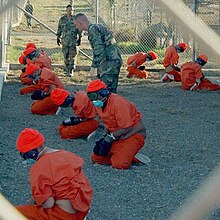Lists of former Guantanamo Bay detainees alleged to have returned to terrorism
Of the 780 people detained there since January 2002 when the military prison first opened after the September 11, 2001 attacks, 731 have been transferred elsewhere, 39 remain there, and 9 have died while in custody.
The standard for inclusion in the "confirmed" category is "a preponderance of information which identifies a specific former Guantanamo detainee as directly involved in terrorist or insurgent activities."
In other words, ODNI considers reengagement "confirmed" if it is more likely than not – i.e., there is at least a 51% chance – that a former detainee is directly involved in terrorist activities.
For inclusion in the "suspected" category, ODNI need only find that there is "[p]lausible but unverified or single-source reporting indicating a specific former GTMO detainee is directly involved in terrorist or insurgent activities."
[5] They offered the names of the three men previously identified: "Mullah Shahzada"; "Maulavi Abdul Ghaffar"; and Abdullah Mahsud.
[5] On July 12, 2007, the Department of Defense placed an additional page on their site, entitled: "Former Guantanamo Detainees who have returned to the fight".
National security expert and CNN analyst Peter Bergen, stated that some of those "suspected" to have returned to terrorism are so categorized because they publicly made anti-American statements, "something that's not surprising if you've been locked up in a U.S. prison camp for several years."
On February 18, 2009, the BBC News reported that UK officials had told them that an Afghan former captive repatriated in the Spring of 2008 had risen to a high-ranking position in the Taliban, in Pakistan, following his return.
The five captives repatriated on April 30, 2008, are: Nasrullah, Esmatulla, Rahmatullah Sangaryar, Sahib Rohullah Wakil, and Abdullah Mohammad Khan.
In March 2009, U.S. officials revealed that Abdullah Ghulam Rasoul (detainee #8) is now leading the Taliban's operations in southern Afghanistan.
"[38][39][40] According to The New York Times Pentagon officials had asserted 74 former captives had returned to terrorism, and had named 29 individuals, including 16 previously unpublished ones.
